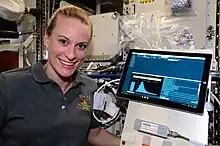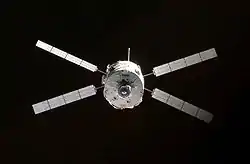貨運飛船
货运飞船是一种为运送物资到达太空而专门设计的航天器,通常为一次性使用,但也有可重复使用设计。主要任务是向空间站定期补给食品、货物、燃料和仪器设备等维持空间站运营的必需品。它是空间站物资和补给的主要来源,也是空间站最为重要的后勤保障系统之一。
| 货运飞船 | |
|---|---|
   .jpg.webp) 现役中的货运飞船: 1、天舟号货运飞船(左上) 2、进步号货运飞船(右上) 3、扩展型天鹅座号货运飞船(左下) 4、货运龙2号飞船(右下) |

| 航天 |
|---|
.jpg.webp) |
|
|
目前现役的货运飞船型号有:俄罗斯的进步号太空船、中国的天舟号货运飞船、SpaceX的货运版龙飞船2号以及诺格创新系统的扩展型天鹅座货运飞船。
功能
货运飞船的主要任务是向空间站定期补给食品、货物、燃料和仪器设备等维持空间站运营的必需品,并以此为基础设计和建造;以龙飞船为例,其主要结构分为加压货舱(外形酷似载人飞船的返回舱,集成有控制和动力系统,同时是目前为数不多的返回式货运飞船货舱)以及非加压货舱(外形酷似载人飞船的推进舱,安装有太阳能帆板,可供机械臂从其末端取出货物,任务结束前被抛弃)[1]。视任务不同,货运飞船的构型也可变化:以天舟飞船为例,其货舱可按任务需要而设置为全密封、半密封和全开放构型[2]。
除运送货物之外,货运飞船亦存在许多其他用途,诸如空间站轨道的维持以及燃料加注:由于现有的大部分空间站均运行在近地轨道而会受到残存的大气阻力影响并逐渐降低轨道高度,故需在其运行高度降低到一定程度前进行轨道抬升,而携带较多燃料的货运飞船便可在空间站的轨道维持方面能发挥重要作用[3]。通常来说,货运飞船既可以直接使用其自带的推进系统来为空间站抬升高度,也可在轨进行燃料补加(如进步号和天舟号)。
目前大部分货运飞船属于一次性航天器,会在其任务末期脱离空间站并携带一系列空间站产生的废品再入大气层烧毁,在某种意义上承担着空间站“垃圾桶”的作用[4]。然而现在也有诸如龙飞船等返回式货运飞船可供空间站货物以及实验数据的下行运输[5]。
货物类型
- Experimentation Equipment
- Phase Change Heat Exchanger
- Heat exchangers are devices used to maintain critical temperatures inside spacecraft. Heat exchangers may remedy the problem of not being able to regulate temperature in space because it has no atmosphere. The phase change heat exchanger has two modes of operation.[6] In the first mode, which uses a freeze cycle, heat exchange fluid is given to the upper flow passageway, which freezes the phase change material at the top.[7] The liquid phase change material at the top is then displaced by the newly-formed phase change material falling to the bottom. In the second mode, which uses a melt cycle, heat exchange fluid is given to the lower passageway to melt the phase change material at the bottom, causing the newly-formed liquid phase change material to be displaced towards the top.[7]
_and_cold_stream_(R11)_in_heat_exchanger.png.webp) Graph generalizing process in a heat exchanger
Graph generalizing process in a heat exchanger
- Heat exchangers are devices used to maintain critical temperatures inside spacecraft. Heat exchangers may remedy the problem of not being able to regulate temperature in space because it has no atmosphere. The phase change heat exchanger has two modes of operation.[6] In the first mode, which uses a freeze cycle, heat exchange fluid is given to the upper flow passageway, which freezes the phase change material at the top.[7] The liquid phase change material at the top is then displaced by the newly-formed phase change material falling to the bottom. In the second mode, which uses a melt cycle, heat exchange fluid is given to the lower passageway to melt the phase change material at the bottom, causing the newly-formed liquid phase change material to be displaced towards the top.[7]
- Nanotube Solar Cell
- A nanotube solar cell is a solar cell designed by the aerospace company Nanoracks that absorbs sunlight more efficiently than traditional solar cells. The Nanotube Solar Cell is three-dimensional, which allows it to have access to the Sun's light in space at every angle while being stationary itself.[8] It is composed of 3-D, carbon nanotube-based photovoltaic devices and copper-zinc-tin-sulfide photo absorbers. They can be implemented into a space station's solar panels to allow for higher power production and usage efficiency.[8] The efficiency of Nanotube Solar Cells also allow for the station to have higher reserves of power to run numerous experiments.[9]
- Biomolecule Sequencer
- A biomolecule sequencer is a tool that can be used by crew members to sequence the DNA of microorganisms outside of Earth.[8] Before the production of the biomolecule sequencer, DNA sequencing was limited to Earth because of the equipment and materials required. The new technology eliminates this restriction, with the added benefit of being able to be used in space. The device can also be used to test the DNA of crew members to monitor their health and bodily reactions to space station projects.[10] In the event that a research study needs to be performed on a space station, the biomolecule sequencer can be used to gather needed biological data.[11]
 NASA astronaut Kathleen Rubins used a biomolecule sequencer in the first-ever sequencing of DNA in space
NASA astronaut Kathleen Rubins used a biomolecule sequencer in the first-ever sequencing of DNA in space
- A biomolecule sequencer is a tool that can be used by crew members to sequence the DNA of microorganisms outside of Earth.[8] Before the production of the biomolecule sequencer, DNA sequencing was limited to Earth because of the equipment and materials required. The new technology eliminates this restriction, with the added benefit of being able to be used in space. The device can also be used to test the DNA of crew members to monitor their health and bodily reactions to space station projects.[10] In the event that a research study needs to be performed on a space station, the biomolecule sequencer can be used to gather needed biological data.[11]
- Phase Change Heat Exchanger
- Essential Equipment
- Compressed Air
- Compressed air is used by astronauts to manage their air supply.[12] It is also utilized for research experiments, and to power boosters for both the ISS and other space vehicles.[12] Compressed air equipment sent to the ISS must be very efficient and low power due to the nature of space to break up fluids.
- Compressed Air
分类
中文语境中的货运飞船因其内置有可供航天员正常活动的生命保障系统而被归类为载人航天器的一种。目前现有的货运飞船除龙飞船之外均属一次性航天器,且多在近地轨道活动。
| 航天器 |
| |||||||||||||||||||||||||||||||||||||||||||||||||||||||||
型号列表
现役型号
已退役型號
研制中的型号
取消型号
- 2007年10月,来自基斯特火箭飞机公司(英語:)[20]的“基斯特K-1”发射载具的相关商业补给计划合同因其方案未能达到NASA要求而被迫中止。此后轨道科学公司的天鹅座号飞船继承了该合同。[21][22]
| 货运飞船 | 进步号 | 航天飞机的多功能模块 | 自動運載飛船(ATV) | HTV货运飞船 HTV-X货运飞船[23] |
龙飞船 龙飞船2号 |
天鹅座号飞船 | 天舟货运飞船 | 逐夢者太空飛機 |
|---|---|---|---|---|---|---|---|---|
| 起飞质量 | 2,2–2,4 t | 9 t | 7,7 t | 6,0 t 5,8 t |
6,0 t[24][25] | 2,0 t (2013) 3,5 t (2015)[26] 3,75 t (2019)[27][28] |
6,5 t (2017) 6,8 t (2021)[29] 7,4 t (2023)[30] |
5,5 t[31] |
| 着陆质量 | 150 kg | 9 t | – | 20 kg (ab HTV-7) | 3,0 t[24][25] | – | – | 1,75 t[31] |
| 运载火箭 | 聯合系列 | 航天飞机 | 亞利安5號 | H-IIB H3 |
獵鷹9號 | 安塔瑞斯 / 擎天神5號 | 长征七号 | Vulcan |
| 成本估算 | 65 Mio. USD[32] | 450 Mio. USD[33] | 600 Mio. USD[34] | HTV: 300–320 Mio. USD[35][36] | 150/230 Mio. USD[37] (Dragon 1/2) |
260/220 Mio. USD[37] (Cygnus 2/3) | 570 Mio. Yuan[38] | |
| Hersteller | 能源火箭 | 泰雷兹阿莱尼亚宇航公司 (MPLM) | 空中巴士國防航天 | 三菱电机 | SpaceX | 軌道科學公司 | 中国空间技术研究院 | 内华达山脉公司 |
| 服役时间 | 1978年至今 | 2001–2011 | 2008–2015 | 2009–2020 | 2012–2020 2020至今 |
2014年至今 | 2017年至今 | 预计2023年夏[39] |
 | ||||||||
照片集
参考文献
- (PDF). SpaceX. 8 September 2009 [19 October 2010]. (原始内容 (PDF)存档于4 January 2011).
- 张建林. . 新京报 (新华网). 2022-05-11 [2022-09-13]. (原始内容存档于2022-11-15).
- . export.shobserver.com. [2022-09-14]. (原始内容存档于2022-09-14).
- . www.gov.cn. [2022-09-14]. (原始内容存档于2022-09-14).
- . www.cnsa.gov.cn. [2022-09-14]. (原始内容存档于2022-09-14).
- US 5220954,Longardner, Robert L. & William J. Longardner,「Phase change heat exchanger」,发表于1993-06-22,指定于Shape Inc.
- Rostami, Morteza; Zahmatkesh, A. . Research Journal of Applied Sciences, Engineering and Technology (Maxwell Scientific Organization). December 2013: 4.
- Rainey, Kristine. . NASA. 2016-06-16 [2021-02-24]. (原始内容存档于2022-01-08).
- . www3.nd.edu. [2021-02-24]. (原始内容存档于2022-07-05).
- Burton, Aaron; John, Kristen; Botkin, Douglas; Castro, Sarah. . 47th Lunar and Planetary Science Conference. March 2016: 2.
- John, K. K.; Botkin, D. J.; Burton, A. S.; Castro-Wallace, S. L.; Chaput, J. D.; Dworkin, J. P.; Lupisella, M. L.; Mason, C. E.; Rubins, K. H.; Smith, D. J.; Stahl, S. . 3Rd International Workshop on Instrumentation for Planetary Mission. 2016-10-01, 1980: 4103 [2022-07-23]. Bibcode:2016LPICo1980.4103J. (原始内容存档于2017-05-11).
- . Cosmonaut Experience. 2019-03-03 [2021-02-24]. (原始内容存档于2022-01-30) (美国英语).
- Gunter's Space Page: Progress-M 1M - 10M (11F615A60, 7KTGM) (页面存档备份,存于).
- . [2021-01-09]. (原始内容存档于2020-11-26).
- . phys.org. 2017-04-20 [2017-04-20]. (原始内容存档于2021-01-27).
- . SpaceX. 2008-12-23 [2010-02-15]. (原始内容存档于2009-07-21).
- . sorae.jp. 2020-01-28 [2020-01-30]. (原始内容存档于2020-11-29).
- . マイナビニュース. 2020-04-02 [2020-05-18]. (原始内容存档于2021-02-28).
- . [4 January 2019]. (原始内容存档于2021-04-26).
- 聂春明. . Beijing Book Co. Inc. https://web.archive.org/web/20220625012107/https://books.google.com/books?id=hBK1DwAAQBAJ&pg=PT160&lpg=PT160&dq=Rocketplane+Kistler%E5%85%AC%E5%8F%B8&source=bl&ots=Uu6WVCc7F_&sig=ACfU3U2tYEjZEKVa_4QFbW0_i_afVgrzAg&hl=zh-CN&sa=X&ved=2ahUKEwiKjbS-usT4AhV8rYkEHRlLAuMQ6AF6BAgQEAM#v=onepage&q=Rocketplane%20Kistler%E5%85%AC%E5%8F%B8&f=false. 2016-06-01 [2022-06-23]. ISBN 978-7-5165-1009-4. (原始内容存档于2022-06-25) (中文). 缺少或
|title=为空 (帮助) - . [2022-06-08]. (原始内容存档于2022-06-08).
- . [2022-06-08]. (原始内容存档于2022-06-17).
- HTV-X (页面存档备份,存于) auf Gunter’s Space Page, abgerufen am 24. September 2019.
- . spacex.com. (原始内容存档于2016-07-14) (英语). 无效
|deadurl=1(帮助) (页面存档备份,存于) - . spacex.com (英语). (页面存档备份,存于)
- . orbitalatk.com (英语). (页面存档备份,存于)
- Eric Berger. . 2018-04-27. (页面存档备份,存于)
- Antares launches Cygnus cargo spacecraft on first CRS-2 mission. Spacenews, 2. November 2019.
- . spaceflightfans.cn. 2021-05-29 (中文). (页面存档备份,存于)
- 赵阳. . news.cn. 2023-04-30 (中文). (页面存档备份,存于)
- . Spaceflight 101. 2017-07-09. (页面存档备份,存于)
- Bernd Leitenberger. . bernd-leitenberger.de. (页面存档备份,存于)
- . NASA. 2019-03-23 (英语). (页面存档备份,存于)
- Stephen Clark. . spaceflightnow.com (英语). (页面存档备份,存于)
- Stephen Clark. . spaceflightnow.com. 2009-12-01 (英语). (页面存档备份,存于)
- Robert Wyre. . majiroxnews.com. 2011-01-19. (原始内容存档于2016-03-02) (英语). 无效
|deadurl=1(帮助) (页面存档备份,存于) - SpaceX price hikes will make ISS cargo missions more costly (页面存档备份,存于). Engadget, 27. April 2018.
- Philip Ye. . weibo.cn. 2023-03-22 (中文). (页面存档备份,存于)
- Peter Michael Schneider: Technik|Raumgleiter. Die neue Kunst des Gleitens. In: P.M. 02/2023, S. 66–73, hier S. 66.





